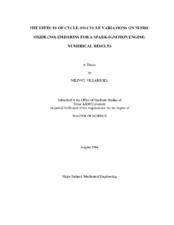The effects of cycle-to-cycle variations on nitric oxide (NO) emissions for a spark-ignition engine: Numerical results
Abstract
The objectives of this study were to 1) determine the effects of cycle-to-cycle variations (ccv) on nitric oxide (NO) emissions, and 2) determine if the consideration of ccv affects the average NO emission as compared to the mean cycle NO emission. To carry out the proposed study, an engine simulation model was used. The simulation determines engine performance and NO emissions as functions of engine operating conditions, engine design parameters, and combustion parameters. An automotive, spark-ignition engine at part load and 1400 rpm was examined in this study. The engine cycle simulation employed three zones for the combustion process: (1) unburned gas, (2) adiabatic core region, and (3) boundary-layer gas. The use of the adiabatic core region has been shown to be especially necessary to capture the production of nitric oxides which are highly temperature dependent.
Past research has shown that cyclic variations in combustion cause ccv of burn duration, ignition delay and equivalence ratio. Furthermore, literature has shown that variations of these three input parameters may be approximated by a normal frequency distribution. Using the mean and standard deviation, and a random number generator, input values were tabulated for the ignition delay, burn duration and equivalence ratio. These three input parameters were then used to simulate cyclic variations in the combustion process.
Calculated results show that cyclic variations of the input parameters cause the cycle-by-cycle NO emissions to increase and decrease by as much as 59% from the mean cycle NO of 3,247 ppm. The average NO emission resulting from ccv was 4.9% less than the mean cycle NO emission. This result indicates that cyclic variations must be considered when calculating the overall NO emissions.
Citation
Villarroel, Milivoy (2004). The effects of cycle-to-cycle variations on nitric oxide (NO) emissions for a spark-ignition engine: Numerical results. Master's thesis, Texas A&M University. Texas A&M University. Available electronically from https : / /hdl .handle .net /1969 .1 /1089.


